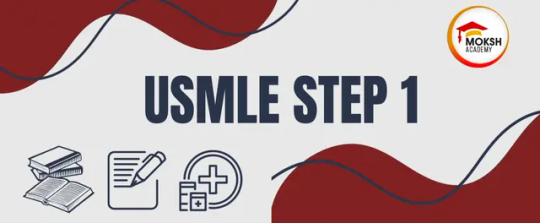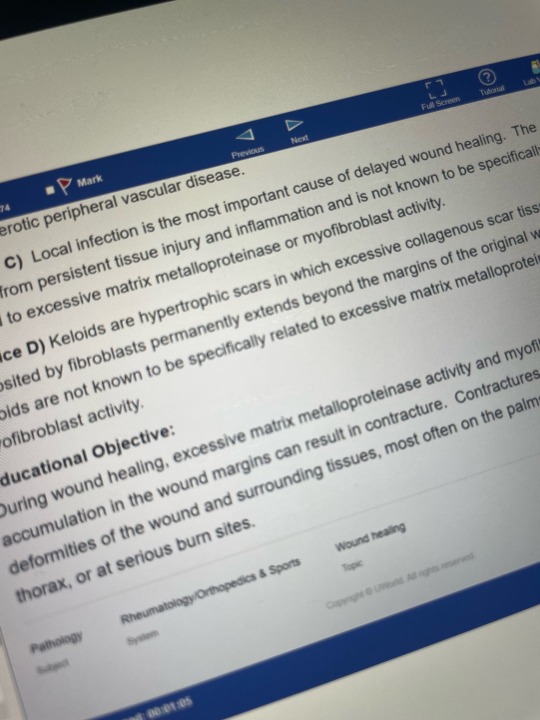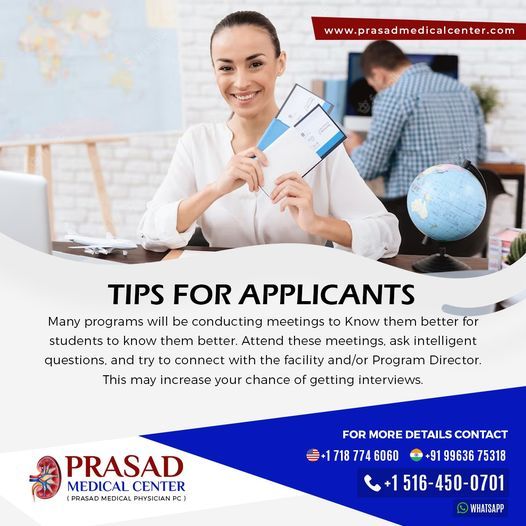#usmle step 1 preparation
Explore tagged Tumblr posts
Text
#usmle#usmle preparation#usmle step 1 preparation#usmle step 2ck preparation#usmle prep#usmle cv#clinicalrotations#residency match
0 notes
Text


4/29/2023
Time has been flying lately — I can’t believe I’ve completed a month of my surgery rotation. Just a couple more weeks of third year left and then it’s on to dedicated studying for step 2 😳🤯
Now it’s time to celebrate since I’ll be on the ophthalmology service for the next couple weeks aka no more 4am alarms 🤩🎉 I’m also looking forward to seeing more pediatric patients after working on general surgery with adult patients the past two weeks.
#emgoesmed#studyblr#studyspo#med student#med school#med studyblr#productivity#weekend#coffee#ms3#clinical rotations#surgery#ophthalmology#USMLE step 2#Im weirdly excited for dedicated#the opposite of how I felt last year#when I was studying for step 1#idk I just feel much better prepared for step 2#Im less overwhelmed#and the material is more interesting to me#Im feeling optimistic about it#:)#and surgery rotation has been weirdly blessed#not one person has yelled at me#and it’s been a month already#feeling very grateful about that lol
28 notes
·
View notes
Text

Refer the above web page for complete guidance for USMLE Step 1 Exam, below is the summary
USMLE Step Guide for Indian Students
To practice medicine in the United States, successfully passing the United States Medical Licensing Examination, commonly known as the USMLE Exam, is mandatory. The USMLE is a three-step exam comprising Step 1, Step 2CK, and Step 3, sponsored by the Federation of State Medical Boards (FSMB) and the National Board of Medical Examiners (NBME). IJSMLE Step 1 is a computer-based exam conducted over one day, evaluating your knowledge of basic sciences crucial for medical practice.
It is typically taken after the second year of medical school and assesses your grasp of essential concepts and principles in basic sciences. The focus is on understanding how these concepts relate to health, disease, and treatment, ensuring a strong foundation for lifelong learning in medicine.
Eligibility Criteria: To be eligible for the USMLE Step 1, you must be:
A current medical student or graduate of a U.S. or Canadian medical school leading to the MD degree, accredited by the Liaison Committee on Medical Education (LCME).
A current medical student or graduate of a U.S. medical school leading to the DO degree, accredited by the American Osteopathic Association (AOA).
For International Medical Graduates (IMGs) to be eligible for the USMLE Step 1, they must:
Be officially enrolled in a medical college or university listed in the World Directory Of Medical Schools (WDOMS).
Fulfill other eligibility criteria specified by the Educational Commission for Foreign Medical Graduates (ECFMG). Refer to the usmle.org website for updated information.
ECFMG Registration: To register for the United States Medical Licensing Examination Step 1, complete the online process through the USMLE website. The registration process includes the following steps:
Create an ECFMG account and apply for ECFMG Certification. Receive your ECFMG ID and password in about two weeks.
Fill out the USMLE Step 1 Application form on the ECFMG website, pay the exam fee, and select your eligibility period within a three-month window.
Complete and mail Form 183 to ECFMG, ensuring the college dean's signature on the form matches the one on file.
Await your scheduling permit from ECFMG, which will be sent via email within 2-3 weeks of mailing Form 183. This permit is crucial for your exam day; review it for accuracy.
#USMLE#Step 1#USMLE Step 1#ecfmg#USMLE coaching#ecfmg registration process#Residency in US#USMLE Coaching Institute#USMLE Preparation#USMLE Online Coaching#MOKSH Academy
1 note
·
View note
Text
youtube
The Best 6 USMLE Step 1 Preparation Plan | USMLE Strike
0 notes
Text
I'm preparing for USMLE STEP 1, and it has been a wild ride so far.
I'll probably give the exam in October, although I haven't set the date yet.
To stay productive, I'll share my studying journey here, mentioning how many blocks I did in a day and what else I did.
I have 85 days to go.
So this is day 1/85.

14 notes
·
View notes
Text




18.05.2023
Bleh day today. I started rewatching demon slayer instead of starting any new show because there are enough uncertainties in my life already. I made a pencil sketch of naruto and my friend asked me to make one for Itachi too, so I started making one. Went for a walk because the sky was pretty but 5 mins outdoors I realised the weather was too humid to enjoy the walk yet I continued to walk for 3kms🙂.
Also on a different note, I always wanted to do a fellowship post MD outside India, I always wanted to experience the learning and working there. I always planned on giving USMLE but I never really prepared for it and I did not want to spend my parent’s money as an MBBS student for the exam preparation when I really did not want to settle down outside India and it was not my main goal. But the idea was always there at the back of my head. Now that I have some free time and I can use my money to spend on resources I am considering giving step 1, so I am planning to keep my knowledge updated and brushed up.
#phtooftheday#medstudlife#studyblr#neetpg#studysthetics#neetpg2023#inicet#medstudynotes#first aid#study mood#medblr#medblog#demon slayer#itachi uchiha#naruto#itachi sketch#study blog#studyblr community#new study blog#new studyblr#study with inspo#studywithme#studystudystudy#study notes#study aesthetic#light academism#light academia#light academic aesthetic#chaotic academic aesthetic#chaotic academia
21 notes
·
View notes
Note
You uhh... you wanna talk about the med school residency, bud?
oh lol i didn't think i was gonna get an ask about it, thanks for asking. i'm actually not quite in residency yet, just med school. 2nd year
just so happens to be the part of med school where you study for this fuckmassive 8 hour exam named USMLE step 1 that covers every part of the curriculum (and also a bunch of outside shit since too many students passing = less money the host company gets to charge us to retake the exam). for perspective, the summary book for it named first aid is ~750 pages long and everything in there is fair game.
people regularly study for this exam with a schedule of ~10 hours a day for 6 weeks straight no breaks. that's what I'm doing now but i wanted to be careful so i planned mine to be 9 weeks. that's bc my med school itself didn't prepare us well for that despite us paying 60k+ tuition a year. a real shit tier lectures and wasted money type of thing. people also regularly experience both physical and mental health problems from studying for the exam to the point it's just expected
i've heard things from current M3s (3rd year med school students) about 24 hour straight shifts while having to study for board exams at the same time. also stuff about residents often having 80 hour work weeks, sometimes without one/both weekend days off. the work itself is naturally strenuous since it's doctor stuff. the sort of situation that gets overworked residents into car crashes from falling asleep at the wheel due to how exhausted they are. fun little article about that phenomenon here. notice that first line "Resident physicians often work longer than 24 consecutive hours with little or no sleep." btw residents get paid ~$20 an hour on average
currently wondering what to do with the fact the next couple years for me are gonna be the (probably? hopefully it won't get worse later?) shittiest time of my life. i can't really get out of that without wasting the preparation i did specifically for this, aka SHITLOAD of grinding i've been doing since start of university so close to a decade now. i realize at this point that this field might not be for me but the concept of exiting now and losing so many years of my life to stress and endless studying for nothing in return + a fuckload of debt makes me pretty unhappy
this probably sounds whiny or something but i'm in not a great spot mentally tbh.
#my friend ben going through the same thing had a full scale breakdown last week due to this + other bad shit that happened in his life#it got me thinking about this whole damn awful process#yeahhh without exaggerating this is the worst time of my life so far. operative words: so far#if any of my followers noticed i've been gone a whole lot this is why#anon
2 notes
·
View notes
Text
30|01|2024 - 25/70 of productivity
There’s still a long road ahead of me. One more regular exam before I can finally go all in with the preparations for the first state exam that I will take in March. It’s quite comparable to the USMLE 1 I would say. It’s a two day written exam and one oral exam. After that, the preclinical semesters will be behind me and I will finally be in my first clinical semester. Oh, how I’m looking forward to that.
My mental health and chronic physical illness took a real toll on me the last years, so I am very proud of how far I’ve come. But now that I’m so close to achieving the first big step (well, actually the second one considering how hard it is to get into med school), my motivation has grown and I’m dedicated to keep studying for the next weeks.
#study motivation#study blog#med student#studyblr#state exam#usmlestep1#mental health#chronic illness#physiology
2 notes
·
View notes
Text
How to Get a Medical Residency in the USA as an International Medical Graduate

Choosing to the medical residency for IMG medical students in USA is the best opt. With world-class training opportunities and state-of-the-art facilities, landing a coveted US residency spot allows you to advance your skills and expertise to the highest level.
However, getting a US medical residency as an IMG involves a step-by-step process with many requirements along the way. By understanding and following the key steps, you’ll place yourself in the best position to match into your desired residency program.
1) Register with the USMLE
Your first step when applying for US residency positions is registering with the United States Medical Licensing Examination (USMLE). The USMLE is a three-step exam assessing an IMG’s medical knowledge and clinical skills. It is a core requirement when applying to US residency programs.
Registering is an easy process online via the USMLE website. You’ll need to create an account and provide background information on your medical education and credentials. This allows you access to schedule test dates and testing center locations.
Registering with the USMLE is the vital first step for IMGs seeking US medical residencies.
2) Pass the USMLE Exams
The next step is successfully passing all required USMLE exams. These are challenging, marathon tests covering a wide range of topics. Thorough preparation through dedicated study time and practice questions is a must.
The USMLE step structure is:
Step 1 - Assesses core concepts in basic medical sciences. Often taken after 2nd year of med school.
Step 2 CK - Focuses on medical knowledge application in clinical settings. Taken during 3rd year typically.
Step 2 CS - Evaluates clinical and communication skills through interactions with standardized patients.
Scoring well on your USMLEs signals to residency programs your strong medical knowledge foundation. It also indicates readiness for the fast-paced rigors of a US residency.
Many IMG applicants space out their exam schedule over a 1-2 year timeframe. Create your own prep timeline backward from desired residency start dates.
Allow plenty of dedicated study time to pass the USMLE exams.
3) Get Valuable Clinical Experience in the USA
In addition to tests, US residencies want applicants exposed to the American healthcare system and culture.
Gaining clinical experience in the US through observerships and clinical electives are a big advantage. These allow you hands-on learning of workflows, systems, treatments, technologies, patient populations, documentation, communication norms and more in American hospitals and clinics.
Observership organizations like Prasad Medical Center (+1 718-774-6060) assist IMGs in securing observership positions across the country. Be sure to research and understand program eligibility terms before applying.
Even a few weeks of US clinical experience can give that important edge among competitive applicants.
US clinical experience highlights adaptability to American medical norms.
4) Register with the AAMC
The Association of American Medical Colleges (AAMC) has two key systems you must access during your application process:
MSPE (Medical Student Performance Evaluation) – Official record of medical education including grades, rankings and assessment.
ERAS (Electronic Residency Application Service) – Centralized online application portal distributing all materials to selected residency programs.
Register with AAMC early to get your credentials verified, understand each platform and have ERAS documentation ready when application season starts.
Connecting with the AAMC is essential throughout the residency hunt.

5) Pick your Residency Programs
When deciding which residency programs to apply for, start broad. Identify specialties matching your interests, strengths and USMLE scores. Use online directories to make a list of reach, reasonable match and safety options across several states or regions.
Factors like location competitiveness, program size, IMG match history and curriculum emphasis can help you categorize options. Have a few safety choices with higher IMG acceptance rates.
Research programs thoroughly to have residency options at each level.
6) Get your ECFMG Token and Register with ERAS
Once programs are selected, activate your ECFMG (Educational Commission for Foreign Medical Graduates) token. This allows ERAS to verify your test scores, credentials and identity when applying.
Next, access your MyERAS applicant profile. Add your exam history, experiences, publications and other credentials that programs will review.
Double and triple check all entries for accuracy before submitting to avoid costly mistakes or delays.
MyERAS is your central application hub throughout the residency process.
7) Finalize Documentation and Submit ERAS Application
With your MyERAS profile complete, finalize all required documentation:
Personal statement
Medical school transcripts
MSPE Dean’s letter
Letters of recommendation (3+)
School catalogues
Proofread all materials thoroughly before uploading to ERAS by the deadlines. Activate program selections and assign supporting documents for each.
Carefully prepare all pieces of your ERAS application package.
8) Medical Residency Interview
With a strong application submitted early, interview offers should follow!
Interview formats vary widely across residencies. Common options include one-on-one, panel interviews, multiple mini interviews (MMIs) and virtual interviews.
Careful preparation is key. Research programs, polish answers to common questions, hone your communication style, dress professionally and send prompt thank you notes.
Treat travel associated interviews as 24/7 assessments of fit. Be gracious, avoid complaining and share your passion for medicine and interest in the program.
Interviews are critical to sealing a residency position – make the most of them!
9) Register with the NRMP
After interviewing, register with the National Resident Matching Program (NRMP) by late January. Creating your NRMP account starts the matching process based on how you rank programs and how they rank applicants.
The yearly Match Day in mid-March reveals results simultaneously to applicants across the country. This coordinated effort fills nearly 40,000 residency roles each spring.
Understand match statistics for given specialties and programs to set realistic expectations before this nerve-wracking day!
Learning match nuances helps ease the anticipation leading up to Match Day!
10) Residency Post-Match Focus
If matched, congratulations on achieving that coveted US residency program spot! Notify all relevant parties, celebrate thoroughly and handle any needed visa application processes.
Review program details to address required paperwork, licensing, preparations or moving requirements before start dates. Share excitements and ask graduated residents for advice as you transition to this intense but rewarding new chapter!
For those not matched, don’t be discouraged! Strategize about strengthening certain areas of your application and discuss options with mentors. Often success comes with perseverance and giving yourself the best opportunities the following year.
We hope this overview gives international medical graduates more clarity on the pathway to getting a US medical residency. While challenging, thousands achieve this goal annually through careful planning, dedication to preparation, and showing your passion for serving US patient populations.
If you still need assistance securing clinical experience or have any other questions along your journey, don’t hesitate to contact the knowledgeable team at Prasad Medical Center at (+1 718-774-6060) or visit https://www.prasadmedicalcenter.com/ We wish you the best of luck in achieving your American medical career dreams!
#usmle#step1#step2#step3#prasadmedicalcenter#medicalresidency#imgstudents#medicalstudents#clinicalresearch#meded
4 notes
·
View notes
Text
The Best USMLE Telegram Channel for 2024-2025: Recalls, Past Papers & Expert Guidance!
The Best USMLE Telegram Channel for 2024-2025: Recalls, Past Papers & Expert Guidance!
Are you preparing for USMLE Step 1, Step 2CK, Step 3, CBSE, NBME, Shelf Exams, or CCSE? Struggling to find real recalls, past questions, and 24/7 expert support? Look no further! Our USMLE Recalls & Exam Guidance Telegram Channel is here to help you succeed with the latest high-yield resources.
🌟 Why Join Our USMLE Telegram Channel?
✔ 1,000+ Active Members – Connect with a global network of medical students and professionals.
✔ Exclusive 2024-2025 Recalls & Past Papers – Stay ahead with real exam content.
✔ 24/7 Expert Guidance & Mentorship – Get personalized strategies and answers anytime.
✔ NBME & CBSE Exam Prep – Boost your performance with proven techniques.
✔ Comprehensive Shelf Exam Support – Master key clinical subjects like Internal Medicine, Surgery, and Psychiatry.
✔ Step 3 & CCSE Resources – Gain access to top study materials for your final hurdle.
🔗 How to Join & Elevate Your USMLE Prep
Ready to supercharge your USMLE preparation? Join our channel and get access to exclusive study materials, expert guidance, and a supportive community today.
🔗 Join Now: USMLE Recalls & Exam Guidance Telegram 📩 Contact Admin: @usmlemasterofrecalls23
🌍 Whether you are in the USA, Canada, UK, India, Australia, UAE, Qatar, or anywhere in the world, this is your go-to hub for USMLE success. Don’t miss out—join today and start preparing smarter! 💯🔥
1 note
·
View note
Text
MBBS in Russia: Affordable & Quality Medical Education for Indian Students
Pursuing MBBS in Russia is a great choice for Indian students looking for affordable and high-quality medical education. Russia has some of the world's best medical universities, offering globally recognized degrees at a fraction of the cost compared to private medical colleges in India.

Why Choose MBBS in Russia?
Affordable Tuition Fees – Studying MBBS in Russia is cost-effective, with fees ranging between 15-30 lakhs INR for the entire course.
Globally Recognized Degree – Russian medical universities are recognized by WHO, NMC, and other global medical bodies.
No Entrance Exam – Unlike India, there is no need for entrance exams like NEET for admission, making the process simpler.
English-Medium Courses – Most universities offer MBBS programs in English, ensuring easy understanding for international students.
Modern Infrastructure – Universities are equipped with advanced laboratories, simulation centers, and state-of-the-art facilities.
Safe & Student-Friendly Environment – Russia provides a safe and multicultural environment for international students.
Top Medical Universities for MBBS in Russia
Here are some of the best medical universities in Russia:
Lomonosov Moscow State University
Kazan Federal University
Saint Petersburg State Medical University
Novosibirsk State University
Orel State University
Siberian State Medical University
These universities provide world-class education with excellent faculty and research opportunities.
Admission Process for MBBS in Russia
The admission process is simple and hassle-free. Follow these steps to secure your seat:
Eligibility Criteria: Students must have at least 50% in PCB (Physics, Chemistry, Biology) in 12th grade.
Application Submission: Fill out the application form online and submit the required documents.
Offer Letter: Once the university approves your application, you will receive an offer letter.
Visa Application: Apply for a student visa with the help of the university.
Travel & Enrollment: After receiving the visa, book your tickets and join the university.
Cost of Studying MBBS in Russia
The overall cost of studying MBBS in Russia is much lower than in other countries. Here’s a breakdown:
Tuition Fees: ₹2.5 lakh - ₹6 lakh per year
Hostel & Living Expenses: ₹10,000 - ₹15,000 per month
Medical Insurance & Other Expenses: ₹30,000 - ₹50,000 per year
Scholarships for MBBS in Russia
Many universities offer scholarships to meritorious students. Some government and private scholarships available for Indian students include:
Russian Government Scholarships
University-Specific Grants
Private Organization Scholarships
Life in Russia for Indian Students
Russia offers a vibrant and diverse lifestyle. Indian students can find Indian restaurants, student communities, and cultural events, making it a home away from home. The country has a cold climate, so students should be prepared for snowy winters.
Career Opportunities After MBBS in Russia
After completing MBBS in Russia, students can:
Return to India – Clear the FMGE/NExT exam to practice in India.
Pursue Higher Studies – Apply for PG programs in Russia, India, or other countries.
Work in Russia – Get licensed to practice in Russian hospitals.
Apply Abroad – Many students qualify for USMLE, PLAB, and other international licensing exams.
FAQs About MBBS in Russia:
1. Is MBBS in Russia valid in India?
Yes, it is valid in India if the university is approved by the National Medical Commission (NMC). Students must clear the FMGE/NExT exam to practice in India.
2. Is NEET required for MBBS in Russia?
Yes, NEET qualification is mandatory for Indian students to get admission to Russian medical universities.
3. Can I work in India after completing MBBS in Russia?
Yes, after clearing the FMGE/NExT exam, you can work as a doctor in India.
4. What is the duration of MBBS in Russia?
The course duration is 6 years, including 1 year of internship.
5. Is Russia safe for Indian students?
Yes, Russia is a safe country with a student-friendly environment and well-secured campuses.
Conclusion
Choosing MBBS in Russia is a smart decision for students who want affordable medical education with global recognition. With excellent infrastructure, experienced faculty, and promising career opportunities, Russian medical universities offer a bright future for aspiring doctors. Start your journey today and achieve your dream of becoming a doctor!
If you need further information contact:
523, 5th Floor, Wave Silver Tower, Sec-18 Noida, UP-201301
+91–7076909090
0 notes
Text

Best USMLE Preparation Platform - Next Steps
Description: We facilitate USMLE aspirants for Step 1 & Step 2CK with self-paced study plan. Our expertly crafted self-paced study plans are designed to fit seamlessly into your busy schedule. We understand the unique needs of each aspirant, and our plans are flexible enough to accommodate various learning styles with USMLE preparation.
usmle, usmle prep, usmle test prep, usmle preparation, usmle guidance, usmle step 1, usmle step 1 preparation, usmle step 2ck, usmle step 2ck preparation, usmle step 3, usmle exam, usmle online class, usmle step by step guidance
#usmle#usmleprep#usmle test prep#usmle preparation#usmle guidance#usmle step 1#usmle step 1 preparation#usmle step 2ck#usmle step 2ck preparation#usmle step 3#usmle exam#usmle online class#usmle step by step guidance
0 notes
Text
USMLE Step Scores by Specialty
For medical graduates planning their next career step, the question of where the United States Medical Licensing Examination (USMLE) is valid often arises. Whether you are aiming to practice medicine in the United States or explore international opportunities, understanding the global recognition of the USMLE is crucial. This guide will cover the countries that accept USMLE scores, the challenges and benefits associated with this exam, and the significance of the USMLE Strike.
Understanding the USMLE Exam
The USMLE, or United States Medical Licensing Examination, is a three-step process that assesses a doctor’s ability to apply medical knowledge and deliver patient care. This exam is designed to ensure that every licensed doctor meets a high standard of medical competency. The three steps include:
Step 1: Focuses on foundational medical sciences such as anatomy, biochemistry, and pathology.
Step 2: Tests clinical knowledge (CK) and clinical skills (CS) through case simulations and practical assessments.
Step 3: Evaluates a doctor’s ability to manage patients independently in a real-world medical setting.
While the USMLE is primarily a requirement for practicing medicine in the United States, it has gained recognition in several other countries. This brings us to the pressing question: Is the USMLE valid in which countries?
Who Conducts the USMLE?
The USMLE is conducted by two primary organizations:
Federation of State Medical Boards (FSMB): Oversees the licensing process across various states in the U.S.
National Board of Medical Examiners (NBME): Works with FSMB to maintain the exam’s high standards and ensure its quality.
These organizations ensure that the examination is credible and reliable, leading to its acceptance beyond the U.S. However, the exam’s validity depends on each country’s policies regarding foreign medical graduates.
Countries That Accept USMLE Scores
Although the USMLE is primarily intended for licensing physicians in the United States, its reputation as a rigorous and credible exam has led several other countries to accept USMLE scores as part of their licensing process. Some notable examples include:
Canada: While Canada has its own medical licensing exam (Medical Council of Canada Qualifying Examination, MCCQE), some provinces may consider USMLE scores, particularly for candidates who have completed their residency in the U.S.
Australia and New Zealand: These countries often accept USMLE scores as part of their assessment pathways for international medical graduates (IMGs), although additional exams or training may be required.
United Arab Emirates (UAE): Physicians with USMLE certification often find it easier to secure medical licenses in the UAE.
Qatar and Saudi Arabia: Similar to the UAE, these countries recognize USMLE scores for credentialing purposes.
India: While the USMLE is not directly recognized for medical practice in India, some exceptions apply, which will be explored further in the next section.
Other countries may consider USMLE scores on a case-by-case basis, especially if the candidate has completed postgraduate training in the U.S. The answer to “Is USMLE valid in which countries?” varies depending on local licensing boards, but the number of countries recognizing the exam continues to grow.
Documents Needed for the USMLE Exam
When preparing for the USMLE, ensure you have the necessary documentation, including:
Proof of Graduation: An official document from your medical school confirming your degree.
Identification: A valid passport or government-issued ID.
ECFMG Certification: Required for international medical graduates to take the exam.
Application Form: Must be completed and submitted via the official USMLE website.
Having these documents ready streamlines the application process and avoids unnecessary delays.
USMLE Examination Requirements for Indian Students
For Indian medical graduates, the USMLE presents numerous opportunities. Key requirements include:
MBBS Degree: The degree must be from a recognized medical college.
ECFMG Certification: Mandatory for international students taking the USMLE.
Eligibility for Step 1 and Step 2: Indian students can take these steps during or after completing their MBBS.
The growing interest in “Is USMLE valid in India?” reflects how the exam has become a vital stepping stone for Indian students aspiring to practice medicine abroad.
Is USMLE Valid in India?
Many students wonder, “Is USMLE valid in India?” While India has its own licensing exams like NEET-PG, the USMLE is not directly recognized for medical practice. However, there are exceptions:
U.S. Returnees: Indian citizens who complete their residency in the U.S. via the USMLE pathway can practice in India.
Global Hospitals: Some international hospitals in India accept USMLE-certified doctors, particularly for research or administrative roles.
While the direct application of the USMLE in India may be limited, the exam holds immense value for those seeking global medical opportunities.
How to Apply for USMLE Outside the USA?
International medical graduates can apply for the USMLE by following these steps:
Register with ECFMG: Create an account on the ECFMG website.
Submit Required Documents: Include proof of graduation, identification, and other necessary paperwork.
Schedule the Exam: Choose your test date and location at Prometric test centers worldwide.
Prepare for the Exam: Use online resources, practice tests, and study materials to enhance your performance.
By following this process, candidates can move closer to achieving their goal of practicing medicine internationally.
USMLE-Recognized Countries: Pros & Cons
Pros:
Global Recognition: The USMLE is a benchmark for medical excellence, opening doors to multiple countries.
Higher Earning Potential: Practicing in countries like the U.S. or Australia offers competitive salaries.
Career Advancement: Many countries value USMLE-certified doctors for specialist roles.
Cons:
Cost: Preparing for and taking the USMLE can be expensive.
Limited Acceptance: Not all countries recognize the USMLE for medical practice.
Additional Requirements: Some countries require supplementary exams or certifications.
Benefits of USMLE for International Doctors
For international doctors, the USMLE provides numerous advantages:
Prestige: Passing the USMLE demonstrates expertise and dedication to medicine.
Opportunities: USMLE certification allows candidates to apply for residency programs in the U.S.
Networking: Provides access to a global network of medical professionals.

Challenges of Using USMLE Outside the U.S.
Despite its advantages, the USMLE also presents challenges:
Regulatory Barriers: Some countries require additional licensing exams, even with USMLE certification.
Financial Costs: Relocating and completing residency in a foreign country can be expensive.
Cultural Adaptation: Practicing medicine in a different healthcare system requires significant adjustments.
Pathways for Practicing in the U.S. After USMLE
After completing the USMLE, candidates can practice in the U.S. by following these steps:
Residency Match: Apply for residency programs through the National Resident Matching Program (NRMP).
Complete Residency: Training lasts 3-7 years, depending on the chosen specialty.
Obtain State Licensing: Secure a license from the medical board in the state where you wish to practice.
Alternative Exams for Practicing Medicine in Different Countries
If the USMLE is not an option, consider these alternatives:
PLAB (UK): Required for practicing medicine in the United Kingdom.
AMC (Australia): The Australian Medical Council exam is essential for international doctors.
MCCQE (Canada): The Medical Council of Canada Qualifying Examination is necessary for licensure in Canada.
Conclusion
The question “Is USMLE valid in which countries?” is essential for international medical graduates. While primarily designed for the U.S., the USMLE is gaining recognition in several countries. Understanding its scope, benefits, and challenges will help medical graduates make informed career decisions. For more details visit https://usmlestrike.com/usmle-step-scores-by-specialty/
0 notes
Text
Study MBBS Abroad: Your Gateway to a Global Medical Career
Why Study MBBS Abroad?
Medical aspirants often dream of becoming doctors, but securing a seat in India can be challenging due to intense competition and high fees. Studying MBBS abroad presents an excellent alternative, offering world-class education, modern infrastructure, and affordable tuition fees.
Benefits of Pursuing MBBS in Abroad
Affordable Education – Compared to private medical colleges in India, many foreign universities offer budget-friendly MBBS programs.
Globally Recognized Degrees – Universities abroad are accredited by WHO, NMC (formerly MCI), ECFMG, and FAIMER, ensuring international recognition.
High-Quality Education & Infrastructure – Countries like Russia, Kyrgyzstan, Kazakhstan, and Guyana have advanced medical facilities, simulation labs, and experienced faculty.
No Entrance Exam Requirement – Many universities admit students based on 12th-grade marks without the need for additional entrance exams like NEET (except for eligibility in India).
Exposure to International Medical Practices – Studying abroad offers multicultural exposure and training in advanced healthcare systems.
Top Destinations for MBBS Abroad
1. Russia
Russia is home to prestigious universities like Perm State Medical University, Mari State University, and Orenburg State Medical University. With affordable fees and an English-medium curriculum, Russia is a preferred choice among Indian students.
2. Kyrgyzstan
Kyrgyzstan offers low-cost MBBS programs with a quality education system. Universities like Kyrgyz State Medical Academy and Osh State University provide globally recognized degrees.
3. Kazakhstan
Kazakhstan has become a hub for MBBS aspirants due to its modern infrastructure and globally accepted degrees from universities like Kazakh National Medical University.
4. Guyana
If you want a US-based medical curriculum, Lincoln American University in Guyana is a great choice. It provides training aligned with USMLE, making it easier to pursue a medical career in the USA.
5. Barbados
Universities like Victoria University of Barbados offer an excellent medical education system, preparing students for international medical licensing exams.
Admission Process for MBBS Abroad
Choose the Right University – Research universities based on budget, accreditation, and student reviews.
Check Eligibility Criteria – Most universities require 50% in Physics, Chemistry, and Biology in 12th grade.
Submit Application – Provide necessary documents like a passport, academic transcripts, and NEET score (if required for Indian students).
Receive Admission Letter – Once approved, you’ll receive an official admission letter.
Apply for Visa – After securing admission, apply for a student visa with the necessary paperwork.
Book Travel & Begin Your Journey – Fly to your chosen destination and start your MBBS journey!
Career Opportunities After MBBS Abroad
Practice in India – Clear the FMGE/NEXT exam to practice in India.
Work Abroad: To practice in other countries, you can take licensing exams like the USMLE (USA), PLAB (UK), AMC (Australia), or DHA (Dubai).
Pursue Post-Graduation – Opt for PG programs in India or abroad for specialization.
Hospital Jobs & Research – Work in international hospitals or pursue medical research.
Final Thoughts
Studying MBBS abroad opens doors to global opportunities, high-quality education, and a cost-effective medical degree. With proper research and planning, you can choose the best university and embark on a successful medical career. If you’re ready to take the next step, explore your options and begin your journey toward becoming a doctor!
#educationabroad#mbbs#mbbs abroad#mbbs fees in abroad#mbbs in russia#mbbs fees in bangladesh#mbbs in kazakhstan#mbbs in kyrgyzstan#mbbs in uzbekistan#mbbs2024
0 notes
Text
First Aid for the USMLE Step 1 2025

First Aid for the USMLE Step 1 2025 is a veritable blueprint for preparing for this critical exam, revealing all the content you will encounter on test day. This unmatched text is written by carefully chosen students who excelled on the Step 1 exam and reviewed by top faculty―ensuring the content is relevant, high-yield, and accurate. The book is organized and formatted in ways that help you easily hone in on the most important content.
The new edition of First Aid for the USMLE Step 1 is filled with 1,000 color clinical images, including more depicting diverse patients; 1,300+ high-yield facts and mnemonics, organized by basic principles and organ system; and invaluable test-taking advice. There’s a reason for the longstanding success of First Aid for the USMLE Step 1. Once you open the 2025 edition, you’ll instantly understand why it’s a resource you can’t be without!
0 notes
Text
SmashUSMLE Reviews: The Ultimate Platform to Ace Your USMLE Exams
The United States Medical Licensing Examination (USMLE) is a crucial milestone in every medical student’s career, determining their readiness to practice medicine in the United States. Given the challenging nature of this three-step examination, choosing the right preparation course can make a significant difference in your success. Among the numerous prep courses available, SmashUSMLE stands out as one of the most effective, comprehensive, and student-friendly options. If you are looking for a structured, high-yield, and efficient way to ace your USMLE exams, SmashUSMLE is the perfect solution for you.
About SmashUSMLE Reviews
SmashUSMLE is an industry leader in USMLE preparation, offering students the best tools and resources to maximize their exam scores. Founded by Dr. Adeleke Adesina, a renowned educator with years of experience in medical training, SmashUSMLE is designed to cater to students at all levels of expertise. The platform provides a unique and innovative learning experience that simplifies complex medical concepts, making them easier to understand and retain.
With thousands of satisfied students who have successfully passed their USMLE Step 1, Step 2 CK, and Step 3 exams, SmashUSMLE has built a reputation for excellence. The reviews and testimonials speak volumes about the effectiveness of the program and the personalized approach it offers to each student.
Courses Offered by SmashUSMLE
SmashUSMLE provides a variety of USMLE prep courses tailored to meet the specific needs of medical students and professionals. The courses include:
1. USMLE Step 1 Prep Course
Comprehensive video lectures covering all Step 1 subjects
High-yield concepts explained in an easy-to-understand manner
Question bank with thousands of practice questions
Detailed explanations and performance tracking
Live coaching and support
2. USMLE Step 2 CK Prep Course
Focused clinical knowledge review
Case-based learning approach
High-yield question bank
Personalized study plans
Live coaching and expert mentorship
3. USMLE Step 3 Prep Course
Integrated approach to clinical decision-making
Video lectures covering Step 3 topics in detail
Advanced question bank with detailed explanations
Simulation of real test conditions
Coaching support for exam strategies
4. Medical Masterclasses
High-yield masterclasses for advanced learning
Topic-based deep dives for efficient retention
Interactive teaching methodology
Real-life case discussions
Designed for students who need extra support in specific areas
Features of Joining SmashUSMLE
SmashUSMLE goes beyond just providing study materials — it offers a complete ecosystem that ensures student success. Here are some key features that set SmashUSMLE apart:
1. Comprehensive Video Lectures
SmashUSMLE provides high-quality, engaging video lectures that simplify complex medical concepts. Dr. Adesina and his team explain difficult topics in a way that is easy to grasp, ensuring students retain critical information.
2. Large and High-Yield Question Bank
With a question bank featuring thousands of high-yield USMLE-style questions, students can practice extensively and identify weak areas that need improvement. Each question comes with detailed explanations, allowing students to learn from their mistakes and strengthen their understanding.
3. Personalized Study Plans
One of the unique aspects of SmashUSMLE is its customized study plans. Students can tailor their preparation strategy based on their schedule, weaknesses, and learning pace. This ensures an efficient and focused approach to studying.
4. Live Coaching and Mentorship
Unlike many other prep courses, SmashUSMLE provides live coaching sessions with experienced mentors. These sessions offer guidance, motivation, and strategies to help students excel in their exams.
5. Performance Analytics and Progress Tracking
SmashUSMLE offers advanced analytics to track student progress. With detailed performance insights, students can identify weak areas and focus on improving them before the actual exam.
6. 24/7 Student Support
The dedicated support team at SmashUSMLE is available around the clock to help students with any queries, technical issues, or study-related concerns.
7. Mobile and Desktop Accessibility
Students can access the SmashUSMLE platform anytime, anywhere using their computers, tablets, or mobile devices. This flexibility allows for seamless learning without restrictions.
Why Choose SmashUSMLE Over Other Prep Courses?
While several USMLE prep courses exist, SmashUSMLE consistently ranks among the best for several compelling reasons:
1. Expert-Led Teaching
The courses are developed and taught by Dr. Adeleke Adesina, an experienced physician and educator who has helped thousands of students pass their USMLE exams with high scores. His teaching style is engaging, interactive, and tailored for medical students of all backgrounds.
2. Proven Track Record of Success
SmashUSMLE boasts an impressive success rate, with many students achieving 250+ scores on their USMLE exams. The positive reviews and success stories speak for themselves.
3. Affordable Pricing Compared to Competitors
Unlike some other prep courses that charge exorbitant fees, SmashUSMLE provides high-quality education at a fraction of the cost, making it accessible to students from all financial backgrounds.
4. Interactive and Engaging Learning Experience
The active learning approach ensures students are not just passively watching videos but are actively engaging with the material through quizzes, live sessions, and discussions.
5. Comprehensive Coverage of Exam Topics
The curriculum covers all high-yield topics needed for the USMLE exams, ensuring that students don’t miss any critical information.
6. Continuous Updates and Improvements
The SmashUSMLE platform is regularly updated to keep up with the latest USMLE exam trends, guidelines, and question formats. This ensures students are always studying the most relevant content.
What Students Say About SmashUSMLE
Thousands of students have benefited from SmashUSMLE and shared their positive experiences:
“SmashUSMLE helped me boost my Step 1 score to 260! The videos and question bank were incredibly effective.” — John D.
“I struggled with Step 2 CK, but SmashUSMLE’s structured approach and live coaching helped me pass with a great score.” — Sarah M.
“Dr. Adesina’s teaching style is phenomenal. He makes difficult concepts easy to understand.” — Mark T.
Conclusion: SmashUSMLE Is Your Key to USMLE Success
Preparing for the USMLE exams can be overwhelming, but with SmashUSMLE, you get the best resources, expert mentorship, and a proven strategy to help you succeed. Whether you are just starting your USMLE journey or need targeted help to improve your scores, SmashUSMLE provides everything you need to excel and achieve your medical dreams.
If you’re serious about passing the USMLE with a high score, join SmashUSMLE today and take the first step toward a successful medical career!
Visit https://www.facebook.com/smashusmle/ for more details
0 notes